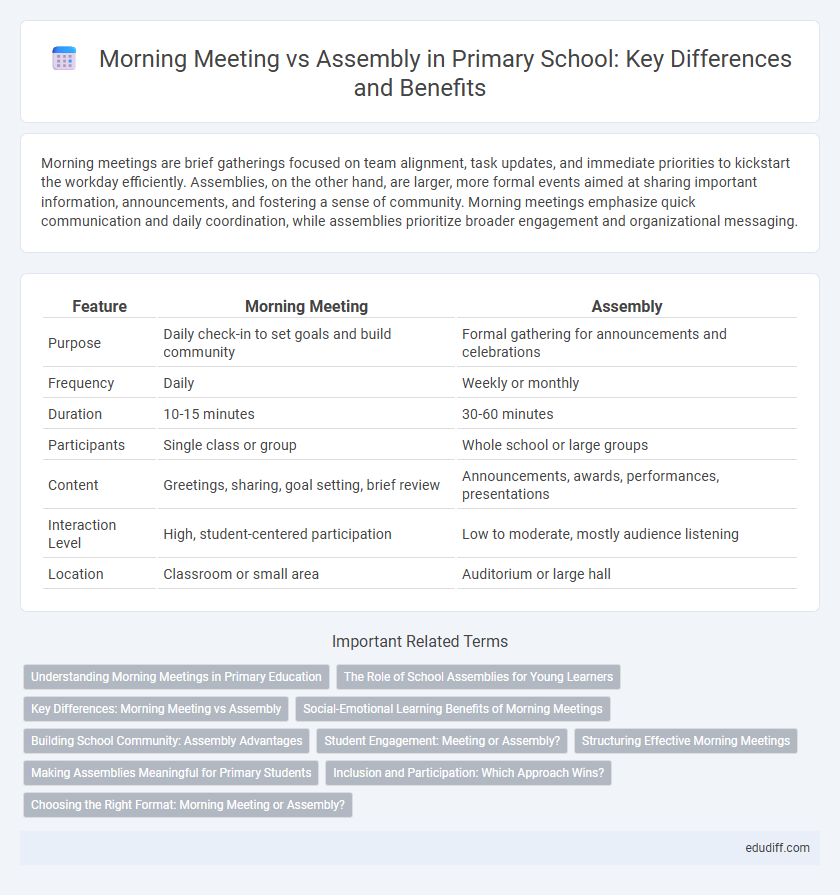Morning meetings are brief gatherings focused on team alignment, task updates, and immediate priorities to kickstart the workday efficiently. Assemblies, on the other hand, are larger, more formal events aimed at sharing important information, announcements, and fostering a sense of community. Morning meetings emphasize quick communication and daily coordination, while assemblies prioritize broader engagement and organizational messaging.
Table of Comparison
| Feature | Morning Meeting | Assembly |
|---|---|---|
| Purpose | Daily check-in to set goals and build community | Formal gathering for announcements and celebrations |
| Frequency | Daily | Weekly or monthly |
| Duration | 10-15 minutes | 30-60 minutes |
| Participants | Single class or group | Whole school or large groups |
| Content | Greetings, sharing, goal setting, brief review | Announcements, awards, performances, presentations |
| Interaction Level | High, student-centered participation | Low to moderate, mostly audience listening |
| Location | Classroom or small area | Auditorium or large hall |
Understanding Morning Meetings in Primary Education
Morning meetings in primary education foster a positive classroom environment by promoting social-emotional learning and daily routine establishment. Unlike assemblies, which are larger and less frequent gatherings for announcements and school-wide activities, morning meetings focus on small group interactions to build community and enhance student engagement. Effective morning meetings integrate greeting, sharing, group activities, and morning message to support students' communication skills and readiness to learn.
The Role of School Assemblies for Young Learners
School assemblies play a crucial role in fostering a sense of community and belonging among young learners by providing a structured environment for collective activities, announcements, and celebrations. Unlike morning meetings, which emphasize small group interactions and social-emotional learning, assemblies bring the entire student body together to promote school-wide values, share important information, and build a unified school culture. This large-scale gathering supports social development, reinforces behavioral expectations, and creates memorable experiences that contribute to students' overall engagement and motivation.
Key Differences: Morning Meeting vs Assembly
Morning Meeting centers on small group interaction, emphasizing social-emotional learning, community building, and daily goal-setting, typically lasting 15-20 minutes. Assembly involves larger gatherings with a broad audience, focusing on announcements, celebrations, or presentations, often spanning 30 minutes or more. The key difference lies in Morning Meeting's personalized, interactive nature versus Assembly's formal, one-to-many communication style.
Social-Emotional Learning Benefits of Morning Meetings
Morning Meetings foster social-emotional learning by creating a structured environment where students build trust, practice empathy, and develop communication skills through daily interactive activities. These meetings promote a sense of community and belonging, which enhances emotional regulation and collaboration among students. Unlike larger assemblies, Morning Meetings provide personalized opportunities for students to express themselves and engage in meaningful social connections.
Building School Community: Assembly Advantages
Assemblies foster a strong school community by bringing together diverse student groups and staff in a shared space, promoting inclusivity and collective identity. The structured environment of an assembly allows for impactful presentations, recognitions, and celebrations that reinforce school values and encourage pride. This collective experience enhances communication and unity, making assemblies a powerful tool for building a cohesive school culture.
Student Engagement: Meeting or Assembly?
Morning meetings foster higher student engagement through interactive activities, personalized check-ins, and collaborative discussions that build a sense of community. Assemblies, while effective for delivering school-wide announcements and large-group instruction, often limit student participation due to their one-way communication format. Prioritizing morning meetings can enhance student voice and active involvement, leading to improved social-emotional learning outcomes.
Structuring Effective Morning Meetings
Morning meetings are structured short gatherings designed to align team goals and prioritize daily tasks, typically lasting 15 to 30 minutes. Unlike assemblies, which are larger and less frequent, morning meetings focus on immediate action steps and direct communication among key team members. Utilizing clear agendas, time limits, and consistent formats enhances productivity and ensures all participants contribute effectively.
Making Assemblies Meaningful for Primary Students
Morning meetings and assemblies serve distinct roles in primary education, with morning meetings fostering daily community building through interactive activities, while assemblies provide structured occasions for larger group communication. Making assemblies meaningful for primary students involves incorporating engaging visuals, interactive elements, and age-appropriate content to maintain attention and promote participation. Prioritizing relevance and student involvement in assemblies enhances social development and reinforces school values in young learners.
Inclusion and Participation: Which Approach Wins?
Morning meetings foster inclusion by encouraging every student to share thoughts in a small, familiar group, promoting active participation and personalized attention. Assemblies often engage larger audiences but can limit individual involvement, making it harder for quieter students to contribute. Prioritizing inclusion, morning meetings typically create a more supportive environment where diverse voices are heard and valued.
Choosing the Right Format: Morning Meeting or Assembly?
Choosing the right format between morning meetings and assemblies depends on the desired level of interaction and audience size; morning meetings foster small group engagement with opportunities for personal check-ins, while assemblies accommodate larger groups with structured presentations. Morning meetings promote social-emotional learning and collaborative problem-solving, making them ideal for team-building and daily planning within classrooms or departments. Assemblies offer a platform for school-wide announcements, celebrations, and guest speakers, supporting community cohesion and information dissemination on a broader scale.
Morning Meeting vs Assembly Infographic

 edudiff.com
edudiff.com